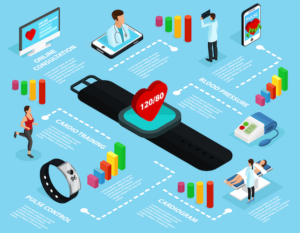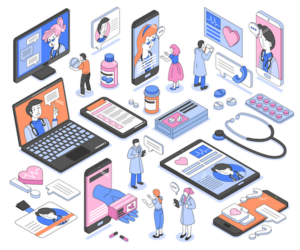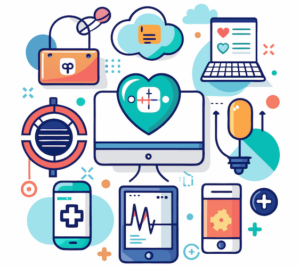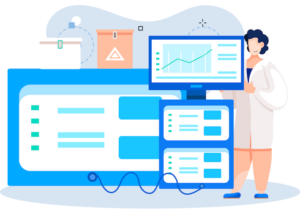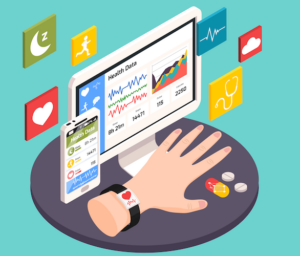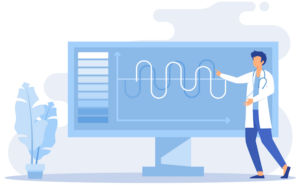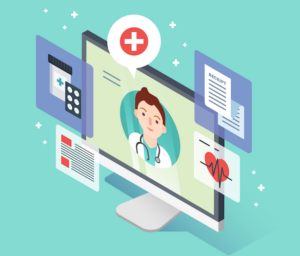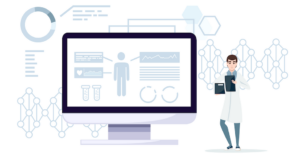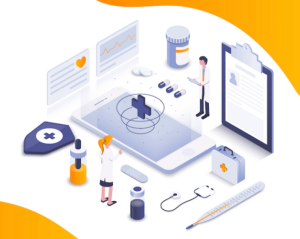In the realm of medical device app development, the stakes are high. Sure, the frequency of software-related recalls has dipped since their peak, but let’s not kid ourselves—the specter of software errors still looms large.
Between 2012 and 2015, the FDA flagged 423 medical device recalls due to user interface software glitches, making up almost half of all software-related recalls in that era.
Fast forward to 2023, and we see Tandem Diabetes Care pulling its Apple iOS app that works with insulin pumps after over 200 reported injuries. These incidents hammer home a crucial point: getting medical device software right from the get-go is non-negotiable.
So, stick around as we dive into best practices for developing medical device software, helping you launch market-ready products that truly gain traction.
Top Takeaways:
- Effective medical device software and app development requires aligning innovative solutions with stringent regulatory standards to ensure patient safety and compliance. Staying ahead of evolving regulations is critical in maintaining both innovation and reliability in your products.
- Understanding the medical device software development process is essential for mitigating risks. Each phase, from concept to deployment, must be meticulously managed to prevent errors that could lead to costly recalls and compromise patient safety.
- Software development for medical devices involves integrating new technologies with legacy systems, creating a seamless user experience. Leveraging AI and IoT can enhance predictive analytics and real-time monitoring, pushing the boundaries of patient care.
Table of Contents:
1. Understanding Medical Device Software
2. Types of Medical Device Software
3. Key Stakeholders in Medical Device Software Development
4. Benefits of Medical Device Software Development for Healthcare Businesses
5. Challenges in Medical Device Software Development
6. Comprehensive Medical Device Software Development Lifecycle
- Step 1: Concept and Feasibility
- Step 2: Requirements and Specifications
- Step 3: Design and Architecture
- Step 4: Development and Implementation
- Step 5: Testing and Validation
- Step 6: Deployment and Maintenance
7. Medical Device Software Development Standards and Certifications
8. Emerging Technologies in Medical Device Software Development
9. Key Performance Indicators for Medical Device Software Projects
10. Cost Considerations for Medical Device Software Projects
11. Security Considerations in Medical Device Software Development
12. Future Trends in Medical Device Software Development
13. How Topflight Helps You Build Medical Device Software
Understanding Medical Device Software
Medical device software is at the forefront of transforming healthcare, enabling everything from accurate diagnostics to seamless patient monitoring. To truly appreciate its impact, it’s essential to delve into the various types of software, their unique applications, and the stakeholders who rely on these advanced tools. Let’s break it down.
Market Size and Growth Projections
The market for medical device software, particularly Software as a Medical Device (SaMD), is on an impressive growth trajectory. In the US, the SaMD market is anticipated to expand at a compound annual growth rate (CAGR) of 13.5% through 2034.
Broadly speaking, the U.S. medical devices market is also set for significant growth. From 2024 to 2029, it is expected to grow at a CAGR of 5.28%, reaching a market volume of $232.6 billion by 2029.
On a global scale, the SaMD market is projected to grow at a CAGR of 13% from 2024 to 2034, aiming to hit $6.1 billion by the end of the forecast period. North America, including the U.S., plays a crucial role in this global landscape, accounting for roughly 23.9% of the market share in 2024.
The key drivers behind these robust growth projections include:
- the accelerating adoption of digital health tools
- continuous regulatory support
- the increasing prevalence of chronic diseases are
Ensure a seamless transition with our expert tips on EHR data migration, minimizing disruptions and maintaining data integrity.
Types of Medical Device Software
Each type has its unique applications, regulatory requirements, and development considerations.
Software as a Medical Device (SaMD) Applications
This is software intended to be used for medical purposes without being part of a hardware medical device. Examples include diagnostic software, mobile medical apps, and software for clinical decision support. SaMD software can operate on various platforms such as smartphones, cloud environments, or desktops.
Enhance your healthcare solutions with effective clinical decision support system implementation to improve patient outcomes and streamline clinical workflows.
Internet of Medical Things (IoMT) Solutions
IoMT refers to interconnected devices in the healthcare environment that collect, analyze, and transmit health data. Examples include smart wearables, remote patient monitoring tools, and connected imaging systems. These tools facilitate continuous monitoring and real-time data analysis, enhancing patient care.
Embedded Medical Software Systems
This type of software is an integral part of medical devices, such as pacemakers, infusion pumps, and imaging machines. Embedded systems control device functions and ensure they operate safely and effectively.
Clinical Information Management Platforms
These include electronic health records (EHR), hospital management systems, and laboratory information systems that streamline clinical workflows and enhance data management.
Key Stakeholders in Medical Device Software Development
Developing medical device software is crucial for a broad range of stakeholders in the healthcare ecosystem.
Healthcare Provider Requirements
Healthcare Providers: Hospitals, clinics, and other healthcare facilities need advanced software tools to enhance clinical decision-making, streamline workflows, and improve patient management. Non-negotiables:
- Safety and time: Zero patient harm, and tasks that fit the 30-second clinician window. Alarm-fatigue controls, clear escalation paths, and downtime modes.
- Interoperability: Native FHIR R4/HL7 v2 pipes, Epic/Cerner-friendly auth (OIDC/SAML SSO), reliable CCD/C-CDA handling, and bulletproof patient/encounter matching.
- Security and compliance: BAA, PHI minimization, audit trails, role-based access, device fleet management (MDM), cert pinning, and SBOM with a patch plan.
- Operations: Versioned configurations, safe rollback, environment parity (dev/stage/prod), and SLAs that include response times and uptime—with on-call you can actually reach.
- Proof it works: Adoption curve, alert-to-action conversion, task time reduction, and outcome deltas (readmission, LOS, no-show rate). If you can’t measure it, it didn’t happen.
Medical Device Manufacturer Needs
Medical Device Manufacturers: Companies that produce medical devices require robust software solutions to ensure their products are safe, effective, and compliant with regulatory standards. Build for submissions—and for the field.
- Regulatory backbone: IEC 62304 SDLC, ISO 14971 risk, IEC 62366-1 usability; full traceability (hazard → requirement → test → evidence) and clean DHF/DMR.
- Architecture: Safety partitions, watchdogs, secure boot, signed OTA, deterministic error handling, and logs that are forensics-grade without leaking PHI.
- V&V depth: Hardware-in-the-loop, worst-case timing, soak tests, simulated patient data, and failure-mode drills (power loss, radio drop, bad firmware).
- Manufacturing and service: Provisioning, calibration, golden image management, and remote diagnostics that won’t brick devices.
- Portfolio strategy: Reusable software platform across SKUs, modular features gated by config—not forks. Pre-Sub where it de-risks the 510(k)/De Novo story.
Patient-Centered Software Solutions
Patients: End-users of medical devices benefit from better health outcomes through tools that offer real-time monitoring, remote diagnostics, and personalized care. If patients won’t use it, nothing else matters.
- Usability: WCAG 2.2 AA, plain language, large tap targets, multilingual, offline-first with graceful sync, and caregiver/proxy access.
- Safety net: Clear “what now?” on abnormal readings, human-in-the-loop when appropriate, and time-to-response guarantees.
- Privacy by default: Transparent consent, granular sharing, export/delete options, and edge processing where feasible. No dark patterns—ever.
- Engagement that respects people: Nudges calibrated to behavior, streaks only if they help adherence, and integrations (Apple Health/Google Fit) that reduce manual effort.
- Equity: Low-bandwidth mode, device-agnostic support, and UX tested on older devices—not just the latest flagship.
Regulatory and Research Applications
Regulatory Bodies: Organizations like the FDA and EMA need reliable software to evaluate and monitor the safety and efficacy of medical devices. Make auditors and IRBs smile (or at least stop frowning).
- Regulatory packages: Crisp intended use, SOUP inventory, cybersecurity posture (threat model, SBOM, coordinated disclosure), patch cadence, and post-market surveillance plan.
- Evidence you can defend: Prespecified statistical analysis, ground-truth labeling audits for ML, bias checks, versioned models with change control and rollback criteria.
- Research workflows: eConsent, IRB documentation, data provenance, HIPAA Safe Harbor/Expert Determination de-identification, and reproducible pipelines.
- Interoperable data: FHIR where clinical, OMOP where research; avoid bespoke schemas unless there’s a life-or-death reason.
- Audit-ready ops: Immutable logs, time-sync across systems, and requirement management mapped to 62304/14971/82304-1 (EU MDR) so inspections don’t become archaeology.
Clinical Researcher Requirements
Clinical Researchers: Software tools aid in collecting, analyzing, and interpreting clinical data, accelerating research and innovation. Design for trial integrity and speed.
- GCP and Part 11 by default: Time-stamped audit trails, validated e-signatures, role-based controls, immutable provenance.
- Data capture that survives audits: eSource↔EDC (REDCap/Medidata) interoperability, ePRO/eCOA with version-locked instruments, device telemetry with clock sync and chain-of-custody.
- Analysis-ready outputs: CDISC SDTM/ADaM exports, OMOP mapping for secondary use, pre-specified SAP with versioned code/data (containers + dataset hashes).
- Randomization/blinding: IWRS integration, allocation concealment, tamper-evident logs; unblind paths gated and audited.
- ML/algorithm endpoints: Pre-registered metrics, locked train/validate splits, site/shift monitoring, model versioning and rollback criteria.
- Monitoring and safety: DSMB dashboards, AE/SAE capture with MedDRA coding, protocol deviation tracking, and interim analyses with stopping rules.
- Ethics and privacy: eConsent with comprehension checks, HIPAA Safe Harbor/Expert Determination, data-sharing packages with risk assessment.
- Ops that scale: Multi-site onboarding, SDV workflows, remote monitoring kits, KPIs (enrollment pace, retention, visit completion, query aging).
Decision test: Could we recreate every figure in the SAP with one command?
Benefits of Medical Device Software Development for Healthcare Businesses
Medical device software developers play a crucial role in advancing the healthcare industry. Here are the key benefits of their work:
Clinical Outcome Improvements through Medical Device Software
Sophisticated software closes the gap between data and decisions—surfacing timely insights where care happens. The goal: safer, earlier interventions and fewer avoidable errors.
- Improving patient care and outcomes
- Real-time monitoring and data analysis
- Personalized treatment plans based on patient data
These capabilities reinforce evidence-based care, support clinician judgment, and adapt to patient context rather than forcing one-size-fits-all protocols.
Operational Excellence with Healthcare Device Software
Operational wins show up as clearer handoffs, fewer clicks, and cleaner data flowing across teams and systems.
- Enhancing operational efficiency
- Streamlined workflows and decision making
- Automated processes reducing manual errors
Learn how to integrate health app with Epic EHR EMR to enhance interoperability and streamline patient data management.
When the right data lands in the right workflow at the right moment, throughput improves, rework drops, and teams spend more time on care—not chasing information.
Competitive Advantages of Advanced Medical Software
Modern software isn’t just an IT upgrade—it’s a strategic edge that accelerates product velocity and market differentiation.
- Driving innovation and competitive advantage
- Adoption of cutting-edge technologies like AI and IoT
Organizations that harness these capabilities iterate faster, uncover new service lines, and sustain a defensible moat as features compound over time.
Regulatory Compliance Benefits
Compliance done well reduces risk and builds trust with patients, providers, and regulators. It also shortens audits and speeds partner approvals.
- Improved risk management and regulatory compliance
Think secure-by-design architectures, traceable changes, validation plans that match device risk, and transparent governance. Strong compliance programs minimize surprises, smooth market access, and keep the team focused on delivering value rather than firefighting.
Challenges in Medical Device Software Development
Navigating the waters of healthcare device software development is no walk in the park. Let’s delve into some of the most pressing issues and how to tackle them head-on.
Legacy System Integration Challenges
Specific challenges in integrating new software with existing systems are often the first roadblock teams face.
One of the biggest stumbling blocks in medical device software development is integrating new medical software with existing systems. Legacy systems often lack the flexibility needed to accommodate new technologies without significant rework. This can result in costly delays and disruptions.
Pragmatically, this means scoping adapters and data mapping early, planning for staged cutovers, and budgeting for surprise refactors when undocumented interfaces surface.
Multi-Stakeholder Design Considerations
Balancing the unique needs of different medical device software users is a perennial challenge.
Each stakeholder in the healthcare ecosystem—be it doctors, nurses, or administrators—has unique needs and requirements. Custom medical device software that caters to one group may not be as effective for another, necessitating a careful balancing act to ensure all user needs are met without overcomplicating the software systems.
A workable approach: separate clinical, operational, and admin views; keep role-based permissions tight; and validate workflows with real users before scaling.
Development Process Optimization
Inefficiencies and bottlenecks in development processes compound risk and cost.
The current development processes often involve multiple handoffs between teams, leading to inefficiencies and bottlenecks. These issues can slow down the development timeline and inflate costs, making it difficult to deliver timely solutions.
Tactically, shrink handoffs with cross-functional squads, automate CI/CD with quality gates, and use traceability (requirements → tests → evidence) to keep velocity without sacrificing compliance.
User Experience Design Challenges
User experience (UX) limitations directly impact adoption and safety.
The lack of user-centric design can severely impact the effectiveness of medical device development software. Clunky or complex interfaces and non-intuitive navigation can lead to user frustration and decreased adoption rates.
Discover the latest trends in healthcare mobile app design to create intuitive and user-friendly applications that enhance patient engagement and streamline healthcare services.
Anchor UX to real clinical moments: prioritize critical tasks, design for low-light/glove use, and test error states—not just happy paths.
Scalability and Interoperability Solutions
Scalability and interoperability issues show up once pilots succeed and volume hits.
Another significant limitation is the lack of scalability and interoperability. Many healthcare organizations find that their existing healthcare software cannot easily scale to meet growing demands or seamlessly integrate with other medical device software engineering efforts.
Also Read: A Complete Guide to Medical Device Integration
Plan for scale with event-driven architectures, well-defined APIs, and versioned data contracts; treat interoperability as a product surface, not a last-mile integration chore.
Regulatory Compliance Navigation
Balancing innovation with regulatory compliance is the tightrope every team must walk.
Balancing the need for innovation with stringent regulatory requirements is a tightrope walk. Innovating too quickly can result in regulatory non-compliance, while focusing too much on compliance can stifle innovation.
FDA regulations for medical device software set the baseline expectations.
The FDA has a rigorous set of guidelines that healthcare device software developers must adhere to. Meeting these guidelines requires meticulous planning and risk management to ensure all aspects of the development process comply with FDA standards.
HIPAA compliance in healthcare device software development adds a continuous data-protection lens.
HIPAA compliance adds another layer of complexity, especially when dealing with patient data. Ensuring that all software systems are HIPAA-compliant involves robust data protection measures and frequent audits.
Related: HIPAA Compliant App Development
International standards and certifications expand the scope across markets.
Medical device software development is not just confined to the U.S. International standards and certifications must also be considered, which can vary significantly from one region to another. This makes the development process even more complex and demanding.
Use a compliance roadmap (FDA + MDR/IVDR + cybersecurity standards) to phase evidence generation and avoid last-minute audit scrambles.
Healthcare device software development is fraught with challenges, from integrating new medical software with legacy systems to navigating the labyrinth of regulatory compliance. However, understanding these challenges and proactively addressing them can pave the way for successful, compliant, and innovative solutions.
Finding the right healthcare app developer is crucial for building robust and secure applications that meet industry standards and patient needs.
Comprehensive Medical Device Software Development Lifecycle
Creating effective medical device software requires a meticulous approach to the development lifecycle, incorporating best practices, and ensuring quality and compliance at every stage. As a seasoned medical device research and development software developer, Topflight is well-versed in navigating these complexities. Let’s break down the software development process for medical devices, highlighting crucial aspects that every medical device software developer should consider.
Agile Development Methodologies for Medical Devices
Agile for regulated products means iterate with evidence. Use short cycles to de-risk assumptions early while mapping stories and increments to design controls and validation. Keep the definition of done tied to testable requirements and traceability so every sprint advances verifiable safety and intended use.
- Time-box discovery and verification tasks alongside features.
- Map each user story to requirements, risks, and tests.
- In sprint reviews, demo working software and updated evidence.
- “Done” = code, tests, and documentation/evidence deltas.
Quality Management System Integration
A lifecycle succeeds only when it plugs into your QMS (ISO 13485 / 21 CFR 820). Treat DHF/DMR/DHR as living artifacts; requirements, risk files, verification, and validation plans should evolve with the backlog. Build QMS hooks into everyday delivery so quality is not a separate lane—it’s the lane.
- PR checklists tied to design controls and cybersecurity.
- Auditable CI that stores test results, reports, and SBOMs.
- Automatic generation of release-ready evidence bundles each increment.
Risk-Based Development Approach
Lead with ISO 14971 risk thinking: identify hazards, estimate risk, specify controls, and prove control effectiveness. Let risk priority drive design depth, test coverage, usability work, and cybersecurity hardening—not feature size or stakeholder enthusiasm.
- Maintain a visible map: hazard → requirement → test → evidence.
- Scale V&V intensity with clinical risk class.
- Treat any risk without a passing, traceable test as unmitigated.
Overview of the Development Lifecycle
The software development process for medical devices is a multi-phase journey that demands precision and expertise. Here’s an overview of the typical stages involved:
| Phase | Key Activities |
|---|---|
| 1. Concept and Feasibility | – Conduct market research to understand healthcare needs and identify gaps. – Perform a technical feasibility study to assess development constraints. |
| 2. Requirements and Specifications | – Document user requirements for end-user needs. – Define functional specifications, focusing on medical data handling, integration, and compliance. |
| 3. Design and Architecture | – Create software design, including user interface and experience. – Develop software architecture to define structure and technologies. |
| 4. Development and Implementation | – Write software code, often using agile methodologies. – Handle embedded medical development for hardware-software integration. |
| 5. Testing and Validation | – Conduct unit, integration, and system tests for quality assurance. – Validate software for regulatory compliance and real-world performance. |
| 6. Deployment and Maintenance | – Deploy the software to end-users with a smooth rollout. – Provide ongoing maintenance through updates, bug fixes, and regulatory adaptations. |
Step 1: Concept and Feasibility
This initial phase involves brainstorming and evaluating ideas, assessing the technical feasibility, and understanding the market needs. It is the foundation upon which the rest of the project is built.
- Market Research: Understanding the needs of healthcare organizations and identifying gaps in current medical software solutions.
- Technical Feasibility Study: Evaluating whether the proposed solution can be developed within the existing technological constraints.
Read more on healthcare app development
Step 2: Requirements and Specifications
Once the concept is validated, the next step is to gather and document detailed requirements and specifications. This phase ensures all stakeholders are aligned on what the final software product will achieve.
- User Requirements: Documenting what the end-users need from the software.
- Functional Specifications: Defining the software’s functionality, including how it will handle medical data, integrate with existing medical systems, and ensure compliance with regulations.
Step 3: Design and Architecture
In this phase, the software design and architecture are formulated. This involves creating detailed blueprints that will guide the development phase.
- Software Design: Detailing the user interface, user experience, and interaction flow.
- Software Architecture: Defining the underlying structure and technologies that will be used.
Step 4: Development and Implementation
This is where the actual coding happens. The medical device software developer team works on building the software according to the specifications and design documents.
- Coding: Writing the software code, often using agile methodologies to ensure iterative progress.
- Embedded Medical Development: For devices requiring embedded systems, this involves programming the hardware-software interface.
Step 5: Testing and Validation
Testing is a critical phase to ensure the software meets all requirements and is free from defects. It involves multiple levels of testing including unit tests, integration tests, and system tests.
- Quality Assurance: Implementing rigorous testing protocols to ensure the software meets quality standards.
- Validation: Ensuring the software complies with all regulatory requirements and performs as expected in real-world scenarios.
Step 6: Deployment and Maintenance
Once the software passes testing and validation, it is deployed into the production environment. Post-deployment, ongoing maintenance is required to address any issues and keep the software up-to-date.
- Deployment: Rolling out the software to end-users and ensuring a smooth transition.
- Software Maintenance: Regular updates and patches to address bugs, improve performance, and adapt to new regulations.
Stay ahead of the curve with insights into web3 development in healthcare, unlocking new possibilities for decentralized and secure healthcare solutions.’
Best Practices for Developing Medical Device Software
To ensure successful medical software development, adhering to best practices is essential. Here are some key best practices every medical device software developer should follow:
Adopting Agile Methodologies
Agile methodologies allow for iterative development, enabling teams to adapt to changes and deliver incremental improvements. This approach is particularly useful in healthcare software development where requirements may evolve.
- Sprint Planning: Breaking down the development process into manageable sprints to ensure steady progress.
- Continuous Integration and Continuous Deployment (CI/CD): Automating the integration and deployment process to catch issues early and deliver updates faster.
Robust Risk Management
Risk management is crucial in medical software development to identify, assess, and mitigate risks that could impact the project.
- Risk Assessment: Identifying potential risks at each stage of the development lifecycle.
- Mitigation Strategies: Developing plans to address identified risks, ensuring they do not derail the project.
User-Centric Design
Focusing on the end-user is paramount. Involving users throughout the development process ensures the final product meets their needs and is easy to use.
- User Feedback: Regularly collecting and incorporating feedback from end-users.
- Usability Testing: Conducting tests to ensure the software is intuitive and efficient for users.
Explore our curated list of the best telemedicine apps to find solutions that offer convenience and accessibility for both patients and providers.
Ensuring Quality and Compliance at Every Stage
Ensuring quality and compliance is non-negotiable in medical device software development. Here’s how to maintain high standards throughout the development lifecycle:
Regulatory Compliance
Compliance with regulations such as FDA guidelines and HIPAA is critical. Non-compliance can result in severe penalties and harm patient safety.
- Regulatory Guidelines: Adhering to FDA regulations, including Design Controls and Software Validation.
- HIPAA Compliance: Implementing robust data protection measures to ensure patient data privacy.
Quality Assurance
Implementing a thorough quality assurance process ensures the software is reliable, safe, and performs as expected.
- Testing Protocols: Using automated and manual testing methods to identify and fix issues.
- Documentation: Keeping detailed records of the development process, testing results, and compliance checks.
Continuous Improvement
Post-deployment, continuous improvement is essential to keep the software relevant and effective.
- Monitoring: Regularly monitoring the software’s performance and user feedback.
- Updates: Providing timely updates to address issues, improve functionality, and comply with new regulations.
The software development process for medical devices is complex and requires a meticulous approach. By following a structured lifecycle, adhering to best practices, and ensuring quality and compliance at every stage, medical device software developers can deliver high-quality, innovative solutions.
At Topflight, we leverage our extensive experience in medical software development to partner with healthcare organizations, providing them with reliable, compliant, and user-friendly software solutions. Whether you’re developing embedded medical systems or enterprise healthcare software, our expertise ensures your project’s success.
Enhance patient interaction and streamline processes with chatbots in healthcare, offering 24/7 support and personalized assistance.
Medical Device Software Development Standards and Certifications
Regulation isn’t paperwork; it’s architecture. These frameworks define what evidence must exist and how it maps to risk—so you can design teams, pipelines, and artifacts to produce that evidence by default (not as a side project).
ISO 13485 Compliance for Software Development
What it governs: Your QMS—how you plan, build, verify, release, and improve devices (and their software).
Applies to: Organizations making or supporting medical devices/medical software.
Outcome: A living system of procedures + records that prove design control, supplier control, CAPA, and production controls.
Core artifacts to expect:
- Documented design controls (plans, reviews, verification/validation), DHF/DMR/DHR alignment.
- Supplier qualification + SOUP/vendor controls tied to risk.
- CAPA with effectiveness checks; internal audits and management reviews.
Practical notes:
- Build QMS hooks into day-to-day delivery (PR checklists, CI evidence drops).
- Avoid the “paper QMS”: if engineers don’t touch it, auditors will.
- Tie QMS roles to code ownership so changes automatically trigger the right records.
Decision test: Could a brand-new engineer ship a change and have all required QMS evidence appear automatically?
IEC 62304 Medical Device Software Lifecycle
What it governs: The software lifecycle—planning, requirements, architecture, implementation, verification, release, problem resolution, maintenance.
Applies to: SaMD and SiMD (software in a medical device), with safety classes A/B/C driving rigor.
Core artifacts to expect:
- Software development plan + configuration/problem-resolution procedures.
- Requirements ↔ architecture ↔ verification traceability.
- SOUP inventory with risk controls; maintenance + anomaly handling.
Practical notes:
- Set software safety class early; it dictates V&V depth and documentation.
- Keep architecture safety partitions explicit; test worst-case timing and failure modes.
- Map 62304 activities to ISO 14971 hazards/controls and IEC 62366-1 usability where risk is user-driven.
Decision test: For each hazard, can you point to a requirement, a control, and a passing test?
FDA Software Validation Requirements
What it governs: Under 21 CFR 820 (Design Controls) and FDA’s Software Validation guidance, you must validate software for its intended use, not just test it. For electronic records/signatures, 21 CFR Part 11 may apply.
Core artifacts to expect:
- Validation plan tied to intended use; acceptance criteria pre-specified.
- Requirements/risks traceability into verification and validation activities.
- Evidence that production-equivalent builds, data, and users were represented.
- For Part 11: audit trails, e-sig controls, security, and record retention.
Practical notes:
- Think “fit for intended use”: simulate real users, environments, and data.
- Calibrate CSV effort by risk; use automated, auditable CI to cut busywork while preserving evidence.
- Pre-Subs can de-risk your approach for novel tech.
Decision test: Could an FDA reviewer follow your validation logic without a meeting?
EU MDR Software Classification
What it governs: Classification rules (notably Rule 11) determine risk class and, in turn, conformity route and evidence burden for software under EU MDR.
Applies to: Software with a medical purpose placed on the EU market (including SaMD).
Core artifacts to expect:
- Classification rationale (e.g., Rule 11), intended purpose, and risk class.
- Technical documentation: GSPRs mapping, clinical/performance evaluation, PMS/PMCF plans.
- Cybersecurity + usability evidence aligned to risk.
Practical notes:
- Small words, big impact: tweak “intended purpose” and your class—and pathway—can change.
- Plan for notified-body expectations on clinical evidence and post-market vigilance early.
- Keep UDI, vigilance, and PMS reporting wired into ops—not spreadsheets.
Decision test: If your “intended purpose” changes by one sentence, do you know exactly how your class and conformity route change?
Emerging Technologies in Medical Device Software Development
Innovation isn’t a luxury in the realm of healthcare technology—it’s a necessity if you’re looking to improve patient outcomes and streamline operations. Let’s dive into how leveraging emerging technologies, streamlining development processes, and automating key tasks can revolutionize medical device software development & test automation.
AI and Machine Learning Applications in Medical Devices
Artificial Intelligence (AI) and Machine Learning (ML) are no longer buzzwords; they’re pivotal in transforming healthcare technology. These advanced technologies can sift through massive datasets to identify patterns and predict outcomes, making them invaluable in medical device software development.
- Predictive Analytics: AI algorithms can analyze patient data to predict health issues before they become critical. For example, AI-powered tools can monitor heart rate and blood pressure trends to forecast potential cardiac events.
- Personalized Treatment Plans: Machine learning models can tailor treatment plans based on individual patient data, enhancing the effectiveness of medical interventions.
- Automated Diagnostics: AI-driven diagnostic tools can quickly analyze medical images and lab results, providing faster and more accurate diagnoses. This not only improves patient care but also alleviates the workload on healthcare professionals.
IoT-Enabled Medical Device Solutions
Internet of Things (IoT) is not just about smart homes and connected cars; it’s revolutionizing healthcare as well. IoT-enabled medical devices can continuously collect and transmit patient data, providing real-time insights into patient health.
- Remote Monitoring: Wearable devices and mobile apps equipped with IoT can monitor vital signs like heart rate and blood pressure, sending data directly to healthcare providers. This enables proactive care and reduces the need for frequent hospital visits.
- Data Collection: IoT devices can facilitate comprehensive data collection, offering a more holistic view of patient health. This data can be invaluable for developing software that offers predictive insights and personalized care.
Cloud-Based Medical Software Architectures
Modern device ecosystems increasingly rely on secure, cloud-based backends to scale analytics, interoperability, and ML workloads. Use HIPAA-ready cloud services (BAAs), data-residency controls, and network-segmented environments to protect PHI. Favor event-driven ingestion, FHIR/API gateways for EHR connectivity, and containerized services to deploy updates safely across fleets. Pair streaming pipelines with model registries so algorithm updates are traceable and roll back cleanly.
Automated Testing and Validation Framework
Automation is a game-changer in medical device software development & test automation. By leveraging AI, you can automate various stages of the development lifecycle, from writing specs to quality assurance. Here’s what using AI for automation of major development processes looks like in practice:
- Automated Code Generation: AI can assist in writing code, reducing manual effort and minimizing the risk of human error. This speeds up the development process and ensures consistency.
- Quality Assurance: AI-driven test automation tools can execute comprehensive test cases rapidly, identifying issues that might be missed by manual testing. Automated testing ensures that the software meets quality standards and complies with regulatory requirements.
- Spec Writing: AI can help in drafting detailed specifications based on initial requirements, streamlining the documentation process and ensuring all aspects are covered.
Understand the cost of EHR implementation to budget effectively and ensure a successful deployment that meets your organization’s needs.
Key Performance Indicators for Medical Device Software Projects
By understanding and implementing the right KPIs, you can better gauge the effectiveness of your efforts and ensure you’re on the right track. Here’s a breakdown of essential KPIs to consider:
Defining Success Metrics
When figuring out how to develop software as a medical device, defining concrete success metrics is the first step. Here’s what to focus on:
- Time to Market: Measure the duration from project initiation to launch. Shorter times indicate more efficient processes.
- Development Cost: Track the overall expenditure involved in the project to ensure it stays within budget.
- Compliance Rate: Ensure adherence to regulatory standards like FDA and HIPAA.
Read more on medical device cost breakdown
Measuring ROI and Patient Outcomes
The ultimate goal is to develop software that not only performs well but also delivers value to patients and healthcare providers. Here are some key metrics:
- Return on Investment (ROI): Calculate the financial return relative to the cost of development.
- Patient Outcomes: Use health metrics such as recovery rates, reduced readmissions, and improved patient engagement as indicators.
- User Adoption Rate: Measure how widely and frequently the software is used within healthcare settings.
Benchmarking Against Industry Standards
Benchmarking your performance against industry standards can provide valuable insights:
- Performance Benchmarks: Compare your software’s performance metrics with industry averages to identify areas for improvement.
- Regulatory Compliance: Regular audits to ensure continuous compliance with industry regulations.
- Customer Satisfaction: Use surveys and feedback to gauge satisfaction levels among healthcare providers and patients.
Understanding how to develop software as a medical device involves more than just technical expertise—it requires a keen eye for key performance indicators. By defining success metrics, measuring ROI and patient outcomes, and benchmarking against industry standards, you can ensure your project not only meets but exceeds expectations. Partnering with an experienced development partner can further enhance your project’s success, providing you with the insights and expertise needed to navigate this complex landscape.
Optimize your practice with medical patient scheduling software, improving efficiency and patient satisfaction through streamlined appointment management.
Cost Considerations for Medical Device Software Projects
Costs aren’t just headcount—they’re the price of evidence, interoperability, and change over time. Treat cost as a design constraint from day one, not an afterthought.
Development Cost Factors
Your build cost is mostly driven by risk and integration, not lines of code. The earlier you lock intended use and safety class, the clearer your V&V depth (and budget) becomes. What moves the number:
- Risk & scope: Intended use and IEC 62304 class (A/B/C) determine verification, documentation, and usability effort.
- Architecture: Safety partitions, secure boot/OTA, provisioning, and telemetry pipelines; platform reuse avoids forked code.
- Interoperability: EHR (FHIR/HL7 v2), identity, device interfaces, and data migration—each adds testing + maintenance tails.
- Verification & validation: Hardware-in-the-loop, worst-case timing, summative usability, and clinical simulations.
- Security & privacy: Threat modeling, SBOM/SCA tooling, pen-tests, auditable logging.
- Program/tooling: eQMS, traceability, CI that emits audit-ready evidence bundles.
- Common traps: late EHR planning, bespoke one-offs where a component would do, and “paper QMS” engineers don’t use.
Regulatory Compliance Costs
Compliance is a recurring line item. Budget for it like you budget for cloud—continuous and proportional to risk. Where the money goes:
- QMS & design controls (ISO 13485): Procedures, DHF/DMR upkeep, internal audits, CAPA effectiveness checks.
- Lifecycle evidence (IEC 62304): Requirements → architecture → tests traceability; SOUP inventory and anomaly handling.
- Risk & usability: ISO 14971 hazards/controls; IEC 62366-1 formative/summative studies and remediation loops.
- FDA validation & Part 11 (as applicable): Validation plans tied to intended use; e-sig/audit trails.
- EU MDR/IVDR: Classification (e.g., Rule 11), tech docs, clinical/performance eval, NB interactions, PMS/PMCF.
Cybersecurity: Coordinated disclosure, periodic pen-tests, secure update evidence.
Maintenance and Update Expenses
The long tail is where budgets drift. Plan for platform churn, post-market changes, and security hygiene—because all three are guaranteed. What to expect after launch:
- Post-market actions: Safety corrections, field notices, re-validation of affected requirements.
- Platform drift: iOS/Android/browser/cloud/EHR version bumps; cert rotation; dependency patching with SBOM tracking.
- Fleet ops: OTA pipelines, diagnostics, log/metric storage, alerting.
- Security hygiene: Regular pen-tests, key rotation, incident-response drills, CAPA follow-through.
- ML upkeep (if AI): Drift monitoring, dataset curation, re-training, controlled rollout/rollback.
- Support SLAs: On-call coverage, uptime/error budgets, success analytics.
Rule of thumb: If it connects or compiles, it will change—budget recurring effort accordingly.
ROI Calculation Methods
Finance cares about outcomes, not roadmaps. Tie features to defensible cash flows and risk reduction.
Start with TCO (3–5 years): development + compliance + cloud/ops + maintenance + support + decommissioning. Then model benefits:
- Revenue: Device sales, subscriptions, per-use fees, reimbursable services.
- Cost avoidance: Fewer manual hours, reduced rework/denials, lower support tickets, shorter cycle times.
- Risk reduction: Fewer incidents/audits, faster approvals via cleaner evidence.
Metrics to show:
- ROI: (Cumulative Benefits − TCO) ÷ TCO
- Payback period: Initial Investment ÷ Annual Net Benefit
- NPV/IRR: Discounted cash flows with sensitivity on adoption, integration scope, and validation depth
Decision test: If a feature can’t be tied to a quantified outcome (revenue, avoided cost, risk reduction) within 12 months, push it out of MVP.
Security Considerations in Medical Device Software Development
When it comes to medical equipment software development, security is paramount. Ensuring the safety and integrity of medical data not only protects patients but also maintains the trust of healthcare providers.
Here’s what to keep in mind:
Cybersecurity Risk Assessment for Medical Devices
Start with a device-centric threat model (patient harm first), then layer asset inventory, SBOM, and coordinated vulnerability disclosure. Tie risks to concrete controls and verification evidence.
Cybersecurity risks:
- Potential for hacking and unauthorized access.
- Risks of data breaches and its impact on patient safety.
- Examples of medical device vulnerabilities.
Additions to operationalize:
- Hazard → threat → control mapping for each interface (BLE/Wi-Fi/USB/Cloud).
- Continuous vuln scanning for third-party components and firmware images.
Data Encryption and Protection Strategies
Protect data in transit and at rest with strong cryptography and sound key management; minimize PHI by design and segment what remains.
Data protection measures:
- Encryption of sensitive medical data.
- Implementing secure authentication protocols.
- Regular security audits and updates.
Additions to operationalize:
- mTLS between device ↔ gateway ↔ cloud; key rotation and HSM-backed KMS.
- Role-based access, short-lived tokens (OIDC/OAuth2), and least-privilege data access.
- Tokenization/pseudonymization where full identifiers aren’t needed.
Network Security for Connected Medical Devices
Assume hostile networks. Isolate clinical traffic, authenticate endpoints, and fail safely when connections degrade.
- Network segmentation (VLANs/medical DMZ), zero-trust policies, and allow-list egress.
- Certificate pinning, firmware signing, and OTA update integrity checks.
- DDoS protection and rate limits at API gateways; anomaly detection on telemetry.
Learn about the latest advancements in medical device integration to enhance connectivity and data sharing across healthcare systems.
Incident Response and Recovery Planning
Plan for failure like it’s inevitable: detect fast, contain precisely, recover safely, and notify responsibly. Rehearse the playbook.
- Triage matrix for clinical impact; clear escalation paths; forensics-ready logging.
- Immutable backups, staged rollbacks for firmware/app, and post-incident CAPA.
Topflight’s compliance strategies:
- Adhering to FDA and HIPAA guidelines.
- Comprehensive risk assessments and mitigation plans.
- Continuous monitoring and real-time security alerts.
Third-Party Security Integration
Vendors and dependencies expand your attack surface—treat them as part of your system, not an afterthought.
- BAA-backed services for any PHI touch; verify their audit reports and patch cadence.
- SSO/IdP hardening (SAML/OIDC), MDM for fleet control, and secure EHR integrations.
- Third-party SBOMs, contractually required vuln disclosures, and sandboxed data exchanges.
Future Trends in Medical Device Software Development
Staying ahead in medical equipment software development means embracing future trends that can revolutionize healthcare technology. Here’s what’s on the horizon:
AI-Powered Diagnostic Software Innovations
AI will continue to raise the ceiling on clinical accuracy and speed—especially where pattern recognition and triage matter most. AI and machine learning integration:
- Enhanced diagnostic tools.
- Predictive analytics for patient care.
- Automation of routine tasks.
Blockchain in Medical Device Data Management
Use blockchain selectively for tamper-evident logs, chain-of-custody, and multi-party data exchange—complementing, not replacing, existing standards. Interoperability and data exchange:
- Seamless integration with existing medical systems.
- Real-time data sharing across platforms.
- Standardization of data formats.
5G-Enabled Remote Healthcare Devices
5G unlocks higher-fidelity telemetry and near–real-time interventions at the edge—useful for imaging, wearables, and at-home diagnostics. Blending with consumer electronics:
- Integration with devices like smartwatches and wristbands.
- Remote monitoring through mobile apps.
- Examples of medical innovations like Apple Health integrations.
Quantum Computing Applications in Medical Software
Near-term impact is exploratory (optimization, molecular simulation, cryptography resilience). Track vendor roadmaps while designing crypto-agile systems so upgrades don’t require rewrites.
Digital Twin Technology for Medical Devices
Patient- and device-level digital twins enable scenario testing, therapy tuning, and predictive maintenance—before you touch a patient or a device in the field. Personalized medicine and precision healthcare:
- Tailored treatment plans based on patient data.
- Use of genetic information for customized therapies.
- Improved patient outcomes through targeted interventions.
Explore the requirements for SaMD certification to ensure your software as a medical device meets regulatory standards and delivers safe, effective solutions.
How Topflight Helps You Build Medical Device Software
Navigating the complexities of medical device software development requires a trusted partner with deep industry expertise. At Topflight, we specialize in creating cutting-edge medical device software that meets stringent regulatory standards while pushing the boundaries of innovation. Here’s how we helped some of our partners:
AllHeartz
Our work with AllHeartz showcases how a smartphone can be transformed into a powerful sensor through advanced AI algorithms. This computer vision RTM app allows for precise remote monitoring, making healthcare more accessible and efficient.
- Utilized AI to reduce in-person visits by up to 50% and clerical work by 80%.
- Enabled patients to conduct at-home exams using a mobile app, improving data accuracy and patient outcomes.
- Implemented real-time pose recognition and interactive charts for better patient monitoring.
- Developed a scalable computer vision platform using cloud-based AI technologies.
- Ensured HIPAA compliance with strong data encryption and secure connections.
Explore the AllHeartz Case Study
Dedica Health
For Dedica Health, we developed a comprehensive web platform integrated with clinically certified medical sensors. This project highlights our capability to develop medical device software that seamlessly integrates with existing medical systems, ensuring reliable data collection and real-time monitoring.
- Monitored over 1,100 patients daily, achieving a $300,000 ARR deal through a SaaS model.
- Streamlined operations with automated routines and health data visualization.
- Integrated clinically certified sensors for accurate data collection and patient monitoring.
- Employed rapid prototyping and continuous development for quick iterations and feature balance.
- Built a secure platform with comprehensive safeguards to protect patient data.
Explore the Dedica Health Case Study
Joovv Light Therapy App
In the Joovv Light Therapy App project, we created an intuitive mobile app that effortlessly integrates with Joovv’s light therapy devices. This app enhances user experience by allowing easy control and monitoring through a smartphone interface.
- Revamped the app to support new hardware, enhancing user engagement with goal setting and session recovery features.
- Ensured compatibility with both legacy and new devices using React Native.
- Developed a web portal for user management and app usage metrics, aiding marketing efforts.
- Achieved HIPAA compliance and adhered to IEC 62304 standards for IoT medical software.
Explore the Joovv Light Therapy App Case Study
Ready to take your medical device software to the next level? Partner with Topflight, a leading software development company, to leverage our top-notch software development services. Let’s develop medical device software that not only meets your needs but exceeds your expectations. Schedule a call with us today to explore how we can transform your healthcare technology initiatives.
By choosing Topflight as your software development partner, you can be confident in receiving high-quality, compliant, and innovative software solutions tailored to your general purpose and specific requirements.
Frequently Asked Questions
What are the phases of medical device development?
The phases include concept and feasibility, design and development, verification and validation, regulatory approval, and deployment and maintenance. Each phase ensures quality and compliance at every stage.
What tech stack is employed in medical device software development?
Typically, a tech stack includes programming languages like C++, Python, or Swift, along with frameworks like React, or Angular. It may also involve databases like SQL and cloud platforms like AWS or Azure.
What is the cost of building a medical device software?
Costs vary widely based on complexity, regulatory requirements, and the development team. Generally, expect to invest anywhere from $100,000 to several million dollars for a market-ready product. However, you can start iterating and verifying traction for the first versions of your software on a much leaner budget.
What are the examples of medical devices?
Examples include pacemakers, insulin pumps, MRI machines, and wearable health monitors. These devices often rely on sophisticated software for functionality and patient care.
How long does it usually take to create medical devices?
Development timelines can range from 18 months to several years, depending on the device’s complexity, regulatory hurdles, and necessary clinical trials.
